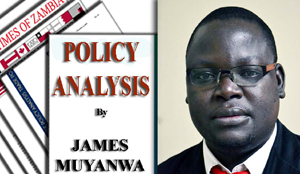 LAST month, Zambia’s rate of inflation sharply went up to the double-digit bracket and reached the highest level in the last six
LAST month, Zambia’s rate of inflation sharply went up to the double-digit bracket and reached the highest level in the last six
years.
The inflation rise from 7.7 per cent to 14.3 per cent did not come as a surprise given the drastic changes in the prices of goods and
services on the market in the last one month or so.
The last time the Central Statistical Office (CSO) recorded such high inflation rate was in May 2009 at 14.7 per cent.
The swift rise in the prices which I directly associate with the sharp fall in the value of the local currency, the Kwacha, has distorted the economic situation in the country.
It should, however, be borne in mind that inflation figures are not futuristic in nature but are in retrospection, being results of what has already taken place in terms of price changes.
From the optimistic point of view, the rise in the inflation may indicate that the country has already gone through the worst and things can only be better, price-wise.
One can only hope that traders will not now start using the inflation rate as the pretext on which to increase the prices, as they did the
fall of the Kwacha.
Inflation reflects the price changes which have already taken place not what will take place!
I say so because it was interesting to note that usually Lusaka Province contributes heavily to the lowering of the inflation rate in
the country but for October it accounted for the highest percentage
point.
This, in my view, is because it was in Lusaka where the effect of the fall in the value of the kwacha was blown out of proportion the most.
“Lusaka Province had the highest provincial contribution of 4.2 percentage points to the overall inflation rate of 14.3 per cent recorded in October 2015.
“This implies that price movements in Lusaka Province had the greatest influence to the overall annual rate of inflation,” said CSO director John Kalumbi.
It is in places like Lusaka where a person trading in tomatoes from his backyard would sharply increase the prices of the tomatoes because the Kwacha had performed badly.
Ironically, a breakdown into provincial figures shows that between October 2014 and October 2015, Lusaka was not even anywhere near the
contributor of the highest annual rate of inflation.
The price increases recorded in Lusaka in October 2015, therefore, could be said to have been artificial, connected to some currency speculative tendencies by some people who benefited from the scenario.
While pondering on this issue, I stumbled on some regional statistics on inflations from among the Common Market for Eastern Africa Southern Africa (COMESA) member countries.
The data, which was made available by head of corporate communication at Comesa secretariat, indicates varying rates of inflation for member countries.
Although the figures are for September 2015, they give a rough picture of the situation in Comesa vis-à-vis the prevailing rates of
inflation.
This is not a way of trying to soothe all Zambians that things are not as bad, but a way of comparing how other Comesa economies are performing.
During the period, Malawi recorded the highest year-on-year inflation rate of 25.4 per cent followed by Sudan at 15.6 while Zimbabwe
recorded the least annual inflation rate of -3.3 per cent.
The year-on-year inflation rate (annual percentage change) in the COMESA region as measured by the Harmonised Consumer Price Index stood at 7.9 per cent for September 2015, up from 6.3 per cent registered in August 2015.
A year earlier the rate was 14.2 per cent.
For comments call: 0955 431442, 0977 246099, 0964 742506 or e-mail:
jmuyanwa@gmail.com.






